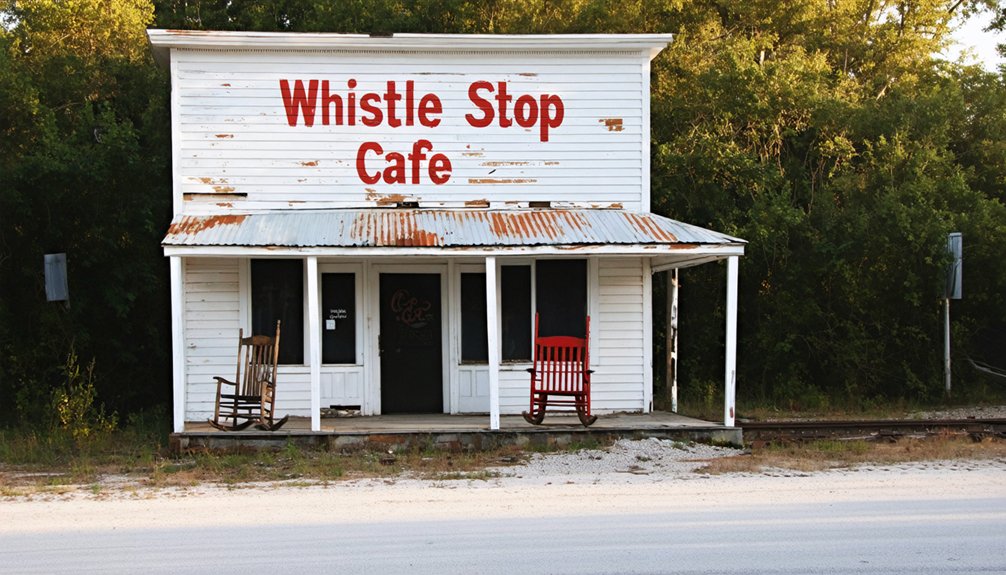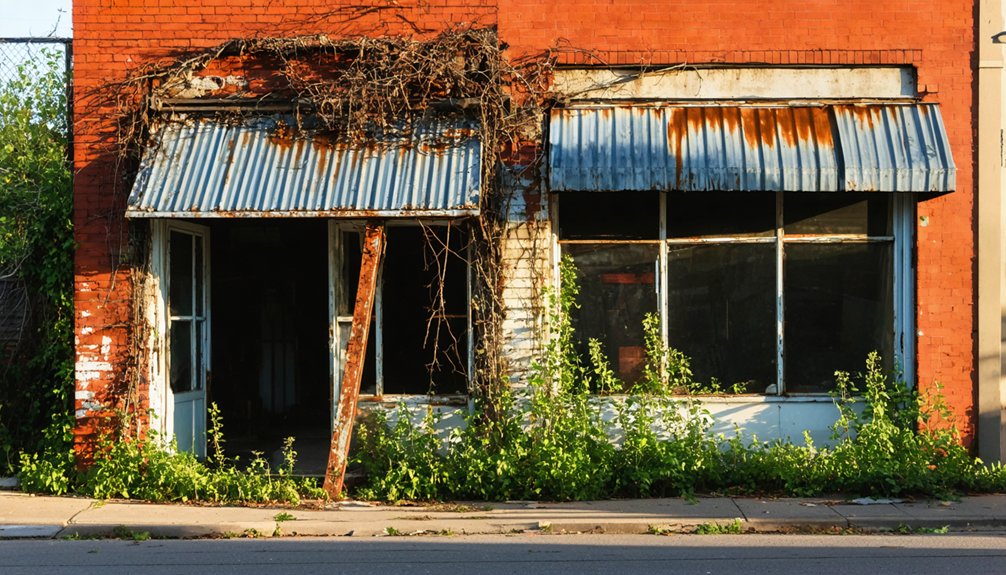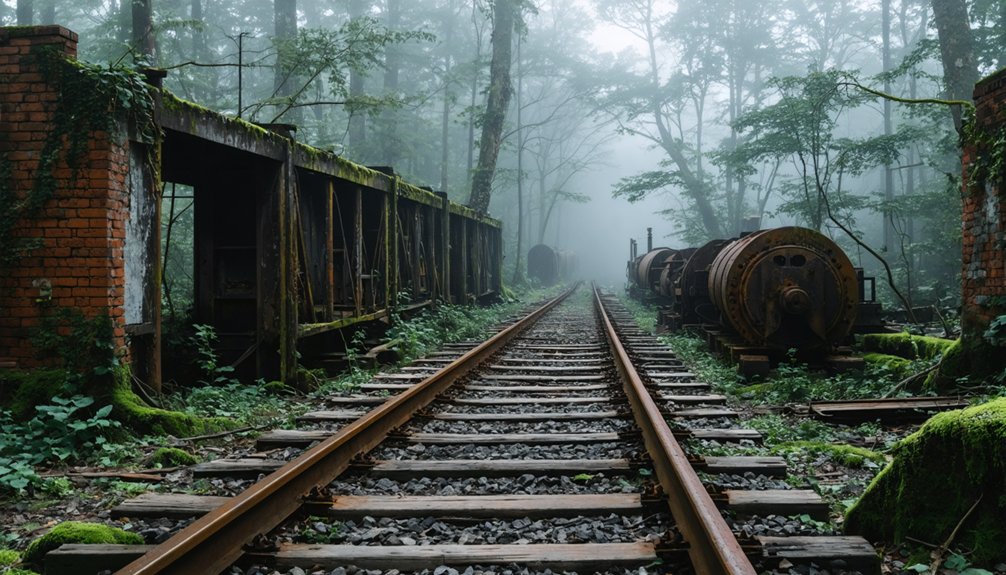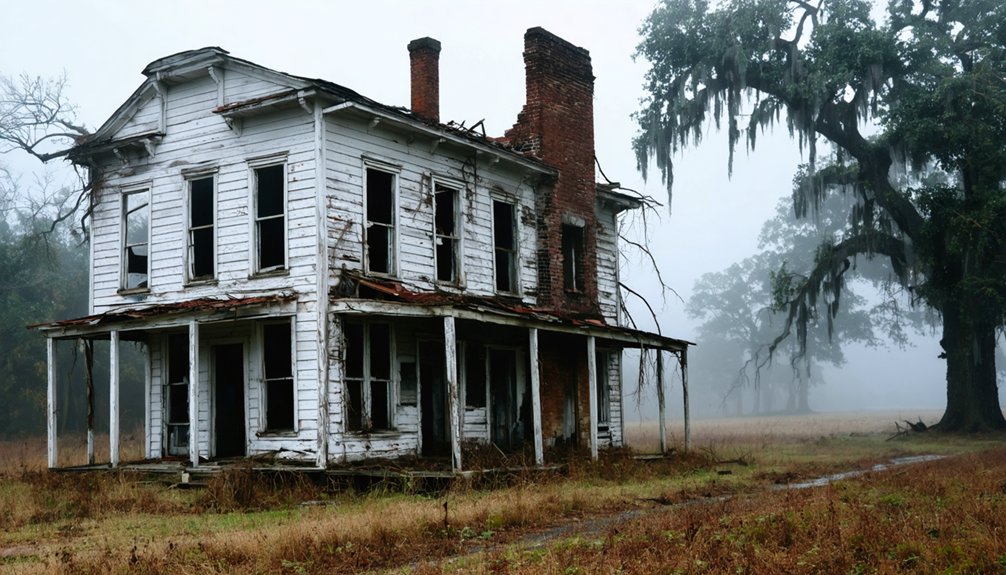You’ll discover Juliette, Georgia’s transformation from a bustling mill town to a ghost town along the Ocmulgee River. After the Southern Railroad’s arrival in 1882, the town flourished with grist and cotton mills, becoming home to the world’s largest water-powered gristmill by 1927. When the mills closed in 1957, Juliette nearly vanished until the filming of “Fried Green Tomatoes” in 1991 revived its spirit. Today, the iconic Whistle Stop Café and preserved mill buildings tell a fascinating story of resilience and reinvention.
Key Takeaways
- Juliette transformed from a bustling mill town into a near ghost town after the Juliette Milling Company closed in 1957.
- The town’s original commercial district declined significantly when Williams’ General Store shuttered its doors in 1972.
- Despite its ghost town status, Juliette experienced revitalization through film tourism after “Fried Green Tomatoes” was filmed there in 1991.
- The historic railroad depot and 115 former company houses stand as remnants of Juliette’s industrial past.
- The Whistle Stop Café and surrounding tourist district now preserve the town’s heritage and prevent complete abandonment.
The Rise and Fall of a Mill Town
While many Georgia towns sprang up around railroads, Juliette’s story began with a simple grist mill along the Ocmulgee River.
The Southern Railroad’s arrival in 1882 brought significant development and growth to the area. You’ll find the town’s roots in Joe Smith’s original operation, which Dr. Glover later transformed into a thriving industrial center. By the 1930s, this modest mill town had grown into a global powerhouse, with the Juliette Milling Company processing over a million bushels of corn annually.
The beloved Williams’ General Store served as the heart of the community for 45 years until its closure in 1972. But like many small industrial towns, Juliette couldn’t escape the winds of change. The 1957 closure of the mill marked the beginning of a steep economic decline.
As the railroad’s importance faded and jobs disappeared, residents packed up and moved away. While tourism later breathed new life into Juliette, particularly after “Fried Green Tomatoes” put it on the map, the quiet streets still whisper tales of its industrial heyday.
Railroad Legacy and Industrial Growth
When you visit Juliette today, you’re walking the same paths where the East Tennessee, Virginia, and Georgia Railroad first established tracks in 1882, transforming a quiet riverside settlement into a bustling transport hub.
The railroad’s arrival sparked immediate growth, with the construction of a depot and the naming of McCrackin Street after the engineer’s daughter, creating the framework for what would become a thriving industrial center. The area had previously been known as Glover, named for the local doctor who built the cotton mill.
Your footsteps along these historic routes trace the path of countless cotton bales, flour sacks, and mill products that once flowed through this essential trading post, connecting Juliette’s industries to national markets. The town’s development was anchored by the Juliette Milling Company, which grew to become the world’s largest water-powered gristmill by 1927.
Early Railroad Settlement Days
As the East Tennessee, Virginia and Georgia Railroad laid its tracks through Monroe County in 1882, the small settlement of Glover’s Mill transformed into the bustling town of Juliette.
You’ll find the railroad origins deeply woven into the town’s identity, from its very name – honoring Juliette McCrackin, a railroad engineer’s daughter – to the lasting legacy of McCrackin Street.
The railroad created essential community connections, establishing Juliette on the west side of the Ocmulgee River in Monroe County, while East Juliette developed across the river in Jones County. Like many towns of the era, depots attracted businesses including lodging establishments, general stores, and service providers.
Dr. Glover’s cotton mill, built near the river, capitalized on these new transportation routes, setting the stage for the town’s industrial boom. The Monroe Railroad charter in 1833 had set an early precedent for rail development in the region.
The railroad depot became the heart of local commerce, connecting farmers and manufacturers to national markets.
Vital Transport Hub Development
The railroad’s arrival in 1882 sparked an unprecedented era of growth that would transform Juliette into an essential transport hub.
The region’s economic development mirrored Savannah’s industrial rise through strategic rail networks.
You’ll find that transportation advancements quickly followed, with a bustling depot facilitating shipping and commerce throughout the region.
The town’s economic connectivity strengthened in 1907 when a strategic bridge replaced the ferry across the Ocmulgee River. For just a nickel toll, you could cross what became the only bridge for miles around.
This crucial crossing, combined with the railroad’s presence, attracted diverse industries including Joe Smith’s gristmill and Dr. Glover’s cotton mill.
Industrial Prosperity Along Tracks
Following the railroad’s arrival in 1882, Juliette’s industrial landscape transformed dramatically along the tracks.
You’d find two powerhouse operations driving the town’s economic transformation: Joe Smith’s grist mill and Dr. Glover’s cotton mill, strategically positioned on opposite banks of the Ocmulgee River.
After 1900, these merged into the innovative Juliette Milling Company, which grew to house the world’s largest water-powered gristmill.
The scale of industrial innovation was remarkable – by the 1930s, the mill processed over a million bushels of corn yearly, shipping Juliette Grits nationwide. Under the leadership of J. M. Birch, the company maintained its position as an industry leader.
The railroad depot became the crucial shipping hub for mill products, while a growing workforce filled 115 company houses.
Together, the rail and mill operations created a bustling industrial center that would define Juliette’s peak era.
From Cotton Mill to Silver Screen
During Juliette’s industrial heyday, cotton and grist mills dominated the town’s landscape, with the Juliette Milling Company processing over a million bushels of corn annually by the 1930s.
You’ll find the concrete mill building, constructed in 1927, still standing as a monument to the town’s cotton heritage and industrial might. Just a few miles away, the Jarrell Plantation site showcases additional historic mill operations including a steam-driven sawmill and cotton gin.
The evolution of Juliette’s iconic structures can be traced through:
- Dr. Glover’s original cotton mill in 1899
- Joe Smith’s grist mill, later acquired by Nathaniel Glover
- The Juliette Milling Company’s expansion under the Birch family
- The final concrete mill of 1927, which would later become a prime location for film adaptations
While the mills closed by 1957, these architectural remnants have transformed from industrial powerhouses into cultural landmarks that draw visitors fascinated by their historical significance.
The Whistle Stop Café Phenomenon

Originally built as a general merchandise store in 1927 by Edward L. Williams Sr., the building that would become the Whistle Stop Café served the community for 45 years before closing its doors.
A humble storefront born in 1927 would later become a cherished landmark, serving its community faithfully for nearly half a century.
You’ll find the spirit of “Miss Lillian” Williams still alive here, where she once helped run the store while raising six children.
The café’s transformation came with the 1991 filming of “Fried Green Tomatoes,” which sparked Juliette’s revival from a fading town to a tourist destination.
Production designer Barbara Ling chose the location for its nearly deserted state.
Today, you can savor authentic southern cuisine Thursday through Monday, though you’ll need to arrive early as they don’t take reservations.
The café’s fame hasn’t changed its small-town charm – it’s still serving up fried green tomatoes and southern hospitality just like in its silver screen debut.
Preserving Historical Architecture
The town’s preservation priorities include:
- Maintaining the iconic Whistle Stop Café, originally a 1927 general store
- Preserving the four-story concrete Juliette Milling Company building
- Protecting historic facades, including movie-era modifications
- Safeguarding railway-influenced structures
While you’re free to explore these historical treasures, you’ll notice some preservation challenges.
Private property restrictions and limited resources affect access to certain sites, like the mill.
Natural elements, particularly flooding, continue to pose ongoing threats to these architectural landmarks, requiring constant vigilance from local preservationists.
Modern Tourism and Cultural Impact

If you’re visiting Juliette today, you’ll find a town that’s been completely transformed by its role in the 1991 film *Fried Green Tomatoes*, with the movie sets carefully preserved and converted into a working tourist district anchored by the famous Whistle Stop Cafe.
The film’s legacy hasn’t just saved historic buildings—it’s created the backbone of Monroe County’s tourism economy, sustaining local businesses and drawing visitors year-round to experience a slice of cinematic Southern charm.
While Juliette retains its small-town character with just 290 residents, the movie’s enduring influence has turned what could have been another forgotten mill town into a unique cultural destination where you can literally step into film history.
Film Tourism Legacy
Since filming “Fried Green Tomatoes” in 1991, Juliette has transformed from a forgotten ghost town into a thriving film tourism destination. The film’s legacy runs deep through the town’s cultural storytelling, with the Whistle Stop Cafe serving as the heart of visitor experiences.
You’ll find the town’s identity firmly anchored in its cinematic heritage through:
- Local businesses that preserve and showcase film memorabilia
- Guided tours highlighting movie locations and behind-the-scenes stories
- Traditional Southern dishes featured in the film served daily
- Multiple film productions choosing Juliette as their backdrop
While tourism initially drove 90% of local business, today’s economy has diversified with growing local patronage.
Yet, the film’s cultural impact remains central to Juliette’s charm, drawing visitors who seek to experience this slice of Southern film history firsthand.
Historic Building Preservation
Following decades of neglect, Juliette’s historic buildings have undergone remarkable transformations through dedicated preservation efforts by local residents and businesses.
You’ll find well-maintained structures throughout town, from the iconic Juliette Milling Company to the carefully preserved storefronts that line the main street.
Community engagement has proven essential in overcoming preservation challenges. While Georgia’s humid climate and maintenance costs pose ongoing concerns, local property owners work diligently to protect these architectural treasures.
Tax incentives and state support help fund necessary repairs, though balancing modern amenities with historical integrity remains tricky. The investment has paid off – these preserved buildings now attract tourists, support local businesses, and maintain property values.
You can experience this living history firsthand through guided tours and educational programs at sites like the Jarrell Plantation.
Local Economy Revival
While many small Southern towns faded into obscurity, Juliette experienced an unexpected renaissance through the 1991 film *Fried Green Tomatoes*.
You’ll find a transformed community where local entrepreneurship thrives on movie-inspired tourism, with the Whistle Stop Café leading the charge as the town’s primary attraction.
The film’s impact on tourism sustainability is evident through:
- Weekend visitors who keep Main Street bustling
- Antique shops like Kudzu Korner that cater to souvenir hunters
- The café’s evolution to serve both tourists and locals
- Preservation of original film sets that maintain authenticity
Despite weekday lulls and seasonal fluctuations, you’ll see how tourism keeps this 290-person community alive.
The town’s businesses have adapted cleverly, offering vintage goods and Southern cuisine while preserving the movie’s cherished atmosphere.
Frequently Asked Questions
How Far Is Juliette From Atlanta?
You’ll find the distance to Atlanta is roughly 56 miles southeast, or about 70 miles if you’re driving via I-75 South. Your travel time typically ranges from 1-2 hours.
Are There Any Ghost Stories or Paranormal Activities Reported in Juliette?
Despite having 290 residents, you won’t find many documented haunted legends or ghost sightings here. While abandoned buildings create an eerie atmosphere, there aren’t credible reports of paranormal activity.
What Is the Current Population of Juliette?
Based on current demographics, you’ll find 290 people living there, according to the 2020 census. Despite its historical significance as a railroad town, the population’s remained relatively stable without major changes.
Can Visitors Explore the Abandoned Cotton Mill Building Today?
No, you can’t explore the abandoned mill – it’s private property with strict no-trespassing rules. Mill safety concerns and deteriorating conditions make unauthorized exploration dangerous and illegal. Exterior viewing is permitted from public areas.
Does Juliette Have Any Annual Festivals or Community Events?
Drawing thousands each fall, you’ll find three major annual celebrations: the Green Tomato Festival in October, Syrup Makin’ Time in November, and the 1823 Artisan Guild’s outdoor painting event.
References
- https://www.southernthing.com/this-tiny-georgia-town-is-preserved-as-film-setting-from-fried-green-tomatoes-2648207641.html
- http://www.friedgreenproducts.com/juliettega/community/history.asp
- https://visitforsythga.com/the-story-of-hollywood-juliette/
- https://static.secure.website/wscfus/7970342/uploads/Juliette.pdf
- https://vanishinggeorgia.com/2023/09/27/juliette-milling-company-1927/
- https://www.youtube.com/watch?v=R-tZ_xa2Qmk
- https://cleanenergy.org/news/a-very-scary-coal-ash-story/
- http://urbanbaboon.blogspot.com/2009/03/east-juliette-dam.html
- https://thegagenweb.com/gajones/juliette.htm
- https://www.bryancountynews.com/opinion/wholesale-observations-juliette-georgia/



